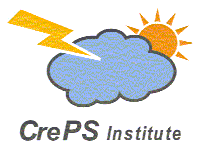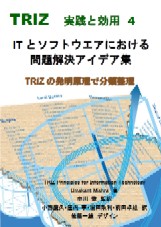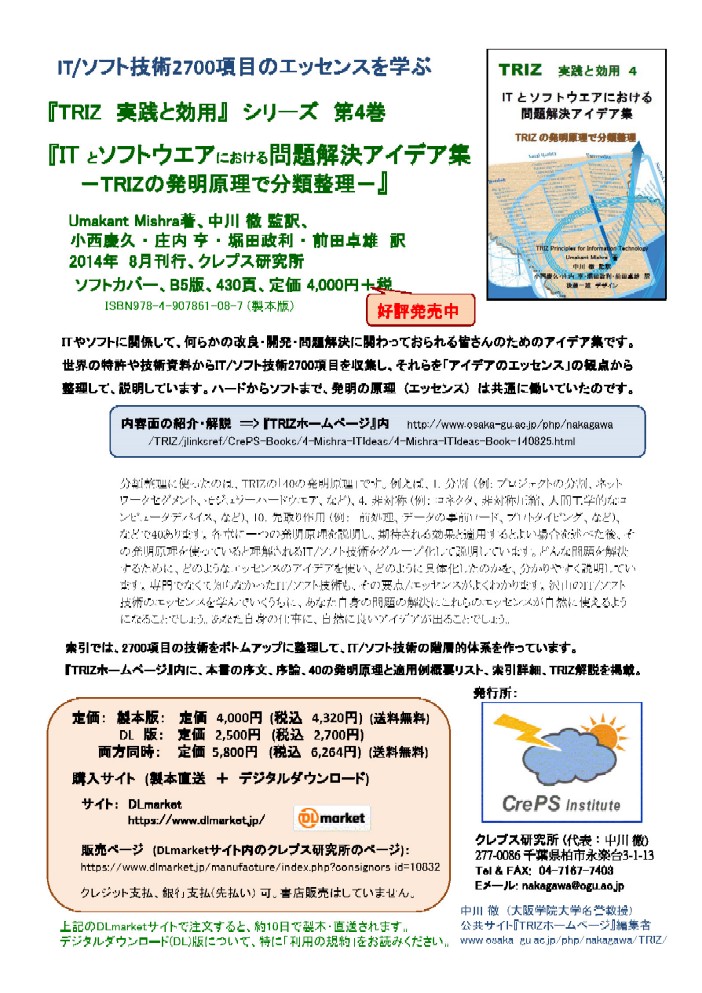 TRIZ Books Publication Announcements: TRIZ Books Publication Announcements: |
  

|
Publication Announcement of the Japanese Edition:
Umakant Mishra's "Treasury of Inventive Ideas for Information Technology & Software - Classified with TRIZ Inventive Principles" |
Original English edition: "Inventive Principles for Information Technology", by Umakant Mishra (India), Final manuscripts: August 2008.
|
Japanese edition published by CrePS Institute in the "TRIZ Practices and Benefits" Series, Vol. 4, on Aug. 25, 2014
Supervising translator: Toru Nakagawa (OGU),
Translators: Yoshihisa Konishi, Toru Shonai, Masatoshi Hotta, and Takuo Maeda
Designer: Kazuo Gotoh
|
Toru Nakagawa (Professor Emeritus of Osaka Gakuin University, and Director of CrePS Institute) |
| Posted: Aug. 29, 2014 |
For going back to Japanese pages, press

buttons.
 Editor's Note and Publication Announcement (Toru Nakagawa, Aug. 29, 2014)
Editor's Note and Publication Announcement (Toru Nakagawa, Aug. 29, 2014)
We have just published the Japanese Edition of Umakant Mishra's book, finally from the CrePS Institute, as a result of struggles over 8 years..
This book is principally dedicated to many people involved in IT and software, as engineers, researchers, PC users, etc. It has collected a large variety of IT/software technologies/techniques and describe what kind of problems they wanted to solve and what kind of ideas were used to solve the problems. The author collected about 3000 cases of IT/SW solutions from US patents and other technical sources, and interpreted the essence of their ideas to solve the individual problems, and classified the cases with the viewpoints of the essence of ideas. The author adopted the 40 Inventive Principles in TRIZ for the basis of the classification, and described the cases in the classified order.
The body of the book is composed of 40 chapters, which are addressed to 40 Principles individually. In each chapter, meaning of the Principle is explained first, and then benefits and application situations come, and finally various application cases of IT/SW technology/techniques are described in groups in more or less detail to clarify how the solution ideas may be generated from the Principle. Despite of so many and different IT/SW cases, the intention or essence of solution idea of each case can be understood from author's description, even for specialized cases not familiar beforehand.
The 40 Inventive Principles in TRIZ were established in the era of 1960s when the computers and software were not yet developed well, but they have been found to very well explain or support the ideas of many inventive cases in the field of IT and software. Once we learn and get familiar with such essence of ideas, in the form of Principles, we will certainly be able to generate some new ideas when we are faced with our own problems, we believe. Mishra's book is a wonderful demonstration of turning a huge complex accumulation of technical knowledge into a treasury of essence of ideas.
The book is published as Vol. 4 of the "TRIZ Practices and Benefits" Series 
 from CrePS Insittute. The book is purchasable in the Internet through the download site DLmarket, in the forms of Print-on-Demand books and downloading PDF files. See the flyer of the series and of this volume. Subsidiary pages and old announcement page are shown at the bottom of this page.
from CrePS Insittute. The book is purchasable in the Internet through the download site DLmarket, in the forms of Print-on-Demand books and downloading PDF files. See the flyer of the series and of this volume. Subsidiary pages and old announcement page are shown at the bottom of this page.
 Publication Outline
Publication Outline
Original English Edition:
"TRIZ Principles for Information Technology"
by Umakant Mishra, India, Final manuscripts in August 2008.
Later published in a Revised and Enlarged Edition,
POD printing by Pothi.com , India
[Currently available on the net through pothi.com at http://pothi.com/ . Sample pages of the book click:  ] ]
|

Click to enlarge |
Japanese Edition:
Title: "Treasury of Inventive Ideas for Information Technology & Software - Classified with TRIZ Inventive Principles" |
Supervising translator: Toru Nakagawa (Osaka Gakuin Univ.)
Translators: Yoshihisa Konishi, Toru Shonai, Masatoshi Hotta, and Takuo Maeda
Designer: Kazuo Gotoh
Publisher: CrePS Institute, Kashiwa, Chiba, Japan
Date of publication: Aug. 25, 2014 |
Publishing style: PoD Book and Digital downloading
Site: DLmarket
Site URL: https://www.dlmarket.jp/
CrePS Institute's page in the DLmarket site:
https://www.dlmarket.jp/manufacture/index.php?consignors_id=10832  |
Styles of publication and prices, etc. (outline) [See the parent page  .]
.]
| |
Printed book |
Digital files |
Both |
| Style |
Soft cover, B5 size, 430 pages, |
PDF file, 7.7 MB,
A4 size, 430 pages, with bookmarks
|
Both of the book and PDF file |
| ISBN |
ISBN978-4-907861-08-7 |
ISBN978-4-907861-07-0 |
Both |
| Price |
4,000 Yen + tax |
2,500 Yen + tax |
5,800 Yen + tax |
 Flyer of this book (PDF)
Flyer of this book (PDF)

 Author's Preface for the Japanese Edition (Umakant Mishra, Aug. 14, 2014)
Author's Preface for the Japanese Edition (Umakant Mishra, Aug. 14, 2014)
We often get surprised to see how some many inventors have solved almost unsolvable problems in the past. We also get surprised to see how the number of patented inventions is growing up when almost everything seems to be already invented! The question arises in our mind whether we can also solve some unsolved problems or do some inventions? Problem solving is a branch of study like other studies, such as, chemistry, philosophy, accountancy, music or journalism. If we can learn any of these studies then she can learn problem solving too. Although the universities currently don’t provide degree courses on problem solving it is not unlikely to see such courses in future.
TRIZ provides some empirical methods to solve complex and difficult problems in a rational way. Anybody can learn these methods and develop the skills of problem solving. Applying forty principles is the simplest among various other TRIZ methods of problem solving. Although only forty principles cannot solve all possible problems they can certainly be applied to most of the problems to get interesting results. Learning and applying forty principles is a good starting point for problem solvers before learning and applying other TRIZ techniques. This book shows many examples and illustrations on how the forty principles can be applied to solve a wide range of problems in the field of computers and information technology.
The world is moving fast on computers and information technology. Microprocessors and computer programs are integrated in phones, cameras, televisions, cars, washing machines, medical equipments and everywhere. The number of software patents has sharply increased during last decade. Apart from the knowledge in the field of invention, an inventor has to keep many things in mind, such as, the latest inventions on the field in different countries, knowledge on associated branches of studies and the techniques of problem solving and invention. While Japanese inventors are working very seriously and contributing significantly to IT inventions, I believe that the knowledge of TRIZ Principles can increase their vision of innovative techniques and ease out their job to solve stronger problems in lesser time.
Dr. Nakagawa has been dedicatedly working on TRIZ research and publications since late nineties. He has not only written many valuable papers on TRIZ and USIT but also translated many contents from other languages to Japanese language for the benefit of Japanese readers. Any of my words will be insufficient to describe the contribution of Dr. Nakagawa to the field of TRIZ in general and his activities to popularize TRIZ among the Japanese people in particular. I am thankful to Dr. Nakagawa and his translating team for their commendable effort in translating this book with dedication and sincerity.
Umakant Mishra, Aug. 14, 2014
 Notes:
Notes:
The following items are posted mostly in the Japanese pages and some in the English pages:,
(a) Brief Introduction to the Book; Flyer of the Book Series  and the Book (PDF);
and the Book (PDF); 
(b) Author's Preface for the Japanese Edition (Umakant Mishra, Aug. 14, 2014) (Above, in English)  (Aug. 29, 2014)
(Aug. 29, 2014)
(c) Translator's Preface for the Japanese Edition (Toru Nakagawa, (1)
 Dec. 15, 2007, (2)
Dec. 15, 2007, (2) 
 Aug. 14, 2011, (3)
Aug. 14, 2011, (3)  Aug. 14,2014)
Aug. 14,2014)  (Aug. 29, 2014)
(Aug. 29, 2014)
(e) Messages from Readers (Masao Kasahara (Osaka Gakuin Univ., Ju. 25, 2011), Toshihiro Hayashi (Aug. 24, 2011), Yoshio Oyanagi (Kobe Univ., Aug. 31, 2011), Naomi Tsuji (Sept. 2, 2011)  (Aug. 29, 2014)
(Aug. 29, 2014)
(g) Introduction (Umakant Mishra) 

(f) (Table of Contents of the Book) Table of 40 TRIZ Principles for IT/Software and their application examples. (Umakant Mishra)
and their application examples. (Umakant Mishra)  (Aug. 29, 2014)
(Aug. 29, 2014)
(g) "Current Situations and Infromation Sources of TRIZ" (in place of Postscript) (Toru Nakagawa, Aug. 14, 2011). Posted in a separate page (in Japanese) (Aug. 22, 2011)
(Aug. 22, 2011)
(h) Index: Index of IT/Software technologies/techniques classified and organized hierarchically (Toru Nakagawa, Aug. 15, 2011)  (PDF 26pages)
(PDF 26pages) 
(i) Profiles of Author and Translators 
See also the old pages of the translation project at the initial stage 
 (Mar. ; Sept. 2008) and at the final stage at SKI
(Mar. ; Sept. 2008) and at the final stage at SKI 
 (Aug. 2011).
(Aug. 2011).
Last updated on Aug. 29, 2014. Access point: Editor: nakagawa@ogu.ac.jp


